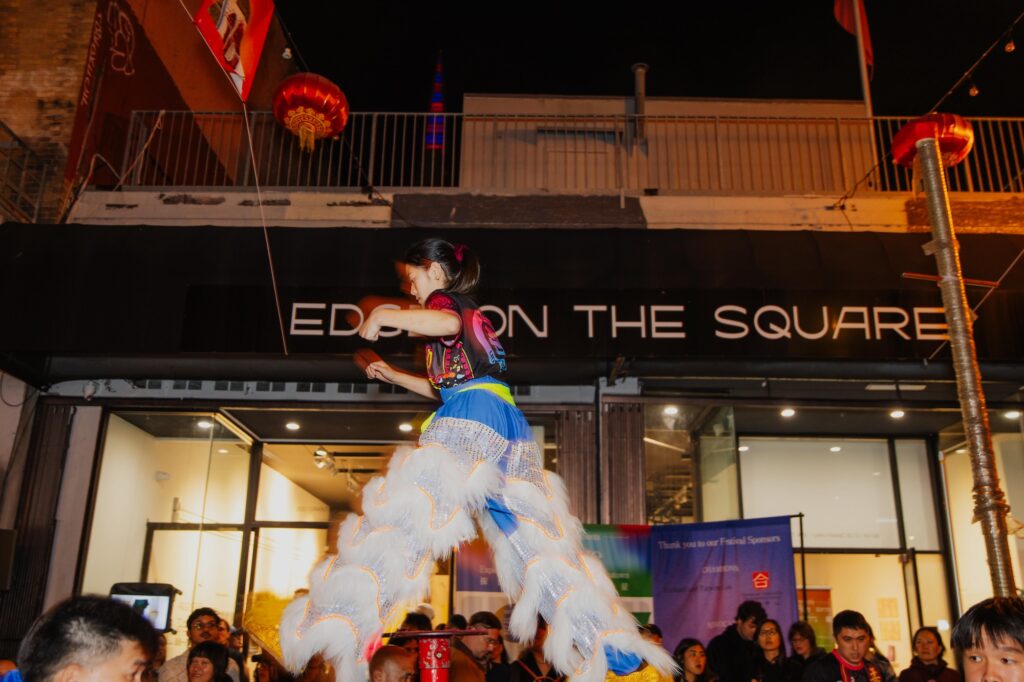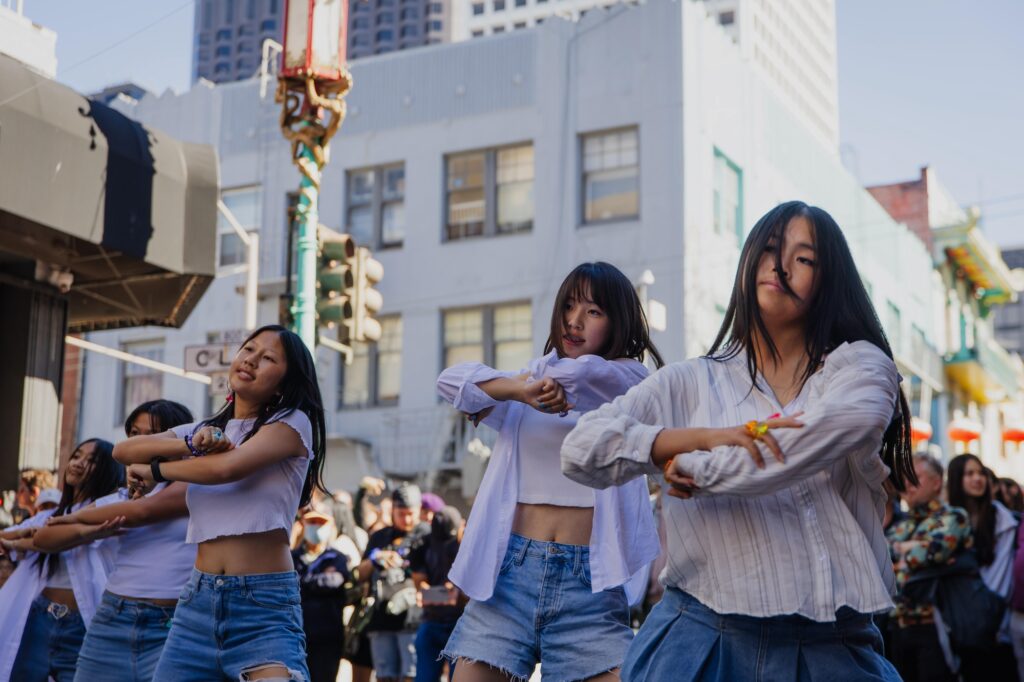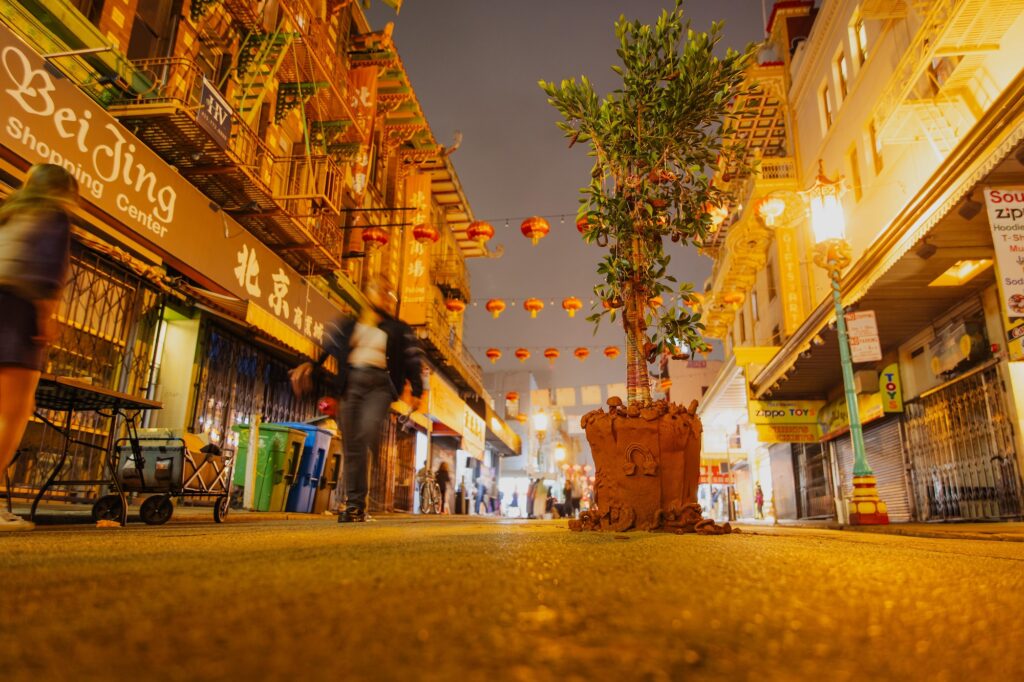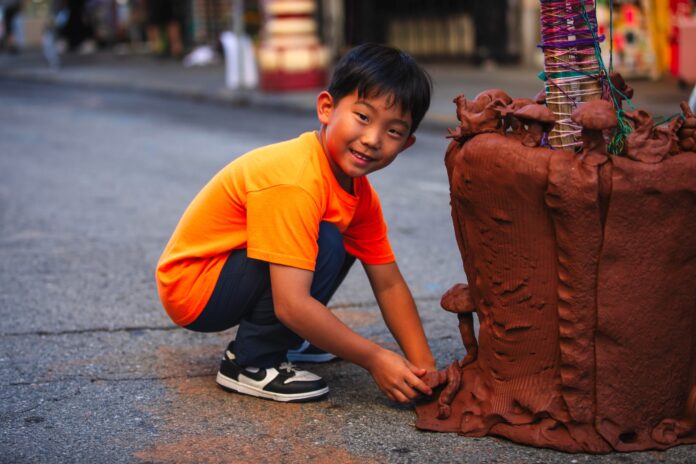A tree in the middle of Grant Avenue, a video exploring the relationship of humans to composting, a river painted on Wentworth Place, a mediation station, a performance by a K-pop dance cover team from Lowell High School…
They were all part of Chinatown contemporary art hub Edge on the Square’s third annual arts festival this past Saturday, spread across several of the neighborhood’s streets. Called High Five: Exploring the Elemental Forces of Chinatown, the event kicked off with music and remarks from members of hip-hop ensemble Audiopharmacy, and speeches from city supervisor Connie Chan, former supervisor and former Chinese Culture Center (CCC) director Mabel Teng, and Edge on the Square director Joanne Lee.
The theme this time around was a crowd pleaser—the five elements. Who doesn’t love the fundamental life forces, especially when they’re interpreted in art installations and performances in Chinatown’s alleys and streets? Earth 土 (Grant Avenue), Fire 火 (Waverly Place), Metal 金 (Ross Alley), Water 水 (Wentworth Place), and Air 气 (Joice Street) were all represented symbolically.
Candace Huey, Edge on the Square’s head curator, told the crowd that the people at the organization view art as an elemental force that stretches boundaries, and that looking at the elements of life reminds us of our connection to the natural world.
Guest curator Trisha Lagaso Goldberg met Huey when she led the “Manifest Differently” exhibition for the Clarion Alley Mural Project at Minnesota Street Project, where Huey’s gallery, re.riddle, is located.
Goldberg lived in Chinatown when she moved here from Hawaii to attend the late, lamented San Francisco Art Institute, so she agreed immediately when Huey asked her to curate a street for the festival. She chose Waverly Place, known for its painted balconies, the delicious Mr. Jiu’s, and being the namesake of a main character in Amy Tan’s 1989 blockbuster novel The Joy Luck Club.

Goldberg picked fire as her element, which she calls both scary and beautiful. “Fire is a really tough element. It feels sacred, in many ways,” she told 48 Hills. “I think in California, fire as an element causes such fear in us with the orange skies and the fire season. I really wanted a moment to think about fire.”
Gabby Miller’s installation SKY MEDITATION, a platform where people were invited to sit or lie down, with Miller leading a short meditation every half hour, was on Waverly. The installation was connected to fire through feeling the warmth in the body, Miller said.
Help us save local journalism!
Every tax-deductible donation helps us grow to cover the issues that mean the most to our community. Become a 48 Hills Hero and support the only daily progressive news source in the Bay Area.
Goldberg says several of the pieces were related to the warmth textiles or clothing give, such as Charlene Tan’s woven installation, Homage to Manang Dulay and Yoriko Yamamoto’s Temari Workshop, where the toys were made with scraps of kimonos. After dark, there was the sonic exploration Brute Force, as well as Eliza O. Barrios’ Returning videos about human composting, shown in the Willie “Woo Woo” Wong Clubhouse on Waverly.
“We talked about how composting produces heat, and that it’s also about sustainability,” Goldberg said. “There’s a kind of honoring land, honoring place.”
The same way Goldberg was glad to curate fire, Colin Choy Kimzey, whose mother grew up in Chinatown, was attracted to water.
“It makes a lot of sense for a festival in Chinatown. Water is the element of the ocean, so it speaks of migration, and Chinese Americans livelihoods have so often been about water,” Kimzey said. “My grandparents come from Toisan, which is very watery. It’s a delta, and they were rice farmers and fishermen.”
Kimzey says Wentworth Place, with its community murals of boats and fish, fits the element perfectly.
“I was excited to be able to pick Wentworth. They used to call it Salty Fish Alley,” he said. “Back when there were Chinese fishermen who could fish on the shores of Hunters Point, or on old shoreline, they would bring their salted fish to Wentworth to sell.”
The alley is right near Portsmouth Square, where the old shoreline was, says artist Vida Kuang. The square got its name because people would go meet the boats there.

Kuang was at Wentworth Place, putting some touches on her street mural River of Life. She pulled up some plastic stools to talk about what she and others had created.
She said she learned a lot about the commodification and privatization of water from a group called Just Transition Alliance.
“I’ve been thinking about how water is more valuable than oil now,” she said. “And how these global, multibillion dollar corporations are buying up water rights.”
Kuang pointed to some Chinese characters in chalk drawn on the blue and green mural on the ground that mean “Defend our Water.” It was also written in English at the end of the alley.
The artist liked the festival’s theme.
“I think it’s a very creative way to activate our public spaces. When you look at elements, it’s something that has been around in many cultures,” she said. “It’s something that all of us have internally within us, so it’s relatable, and it’s an idea that’s accessible.”
Ashwini Bhat, who was contributing a performance and installation called WISH YOU WERE HERE—containing a tree (the one in the middle of Grant Avenue), thread, and clay—considered that accessibility when Huey asked her to create a work for the Earth element.
“As someone who works with clay, I immediately said yes,” said Bhat, who also has a background in Indian classical dance. “But I was also thinking about what could work as a project which is accessible to anybody who is passing by, of any age.”

Last year, artist Jeffrey Yip participated in the festival with a group he co-founded, Macro Waves, a collective of designers and artists of color, specializing in immersive experiences. This year Yip created an augmented reality space for each element, making them as playful as possible. He loves working with the festival.
“I think it encourages a lot of that kind of beauty and the culture that comes out of Chinatown,” he said. “For me, it’s been kind of transformative to come back and work with my people in my community.”
One attendee, Adrian, came up from San Mateo to check out High Five because he’s interested in the arts.
“I’m trying to get more involved with the community,” he said. “I’m a graphic designer, so I think it’s important to be involved and in touch with the community here, especially as an Asian American.”
Fellow attendees Evan and Tania were wandering down Joice Street, where Aay Preston-Myint had curated the air element of the fest. They took the 1 bus from the Richmond to the festival, which they had learned about on Instagram. Tania said she wanted to come because she loves Chinatown and found the idea of using the elements “fun and cheeky.”
Evan, who plays kickball in a field nearby and walks through Chinatown to catch the bus home, was interested to see what the festival had to offer.
“I saw the website and it had a lot of sick graphic design, and it was clear there were a ton of people were involved,” he said. “Different people I had talked to had recognized some artists’ names, so I knew there were some legit artists.”
Edge on the Square isn’t the only organization working on revitalizing Chinatown through the arts. Recently, the CCC and San Francisco Arts Commission announced that more than $2 million will go to the Chinatown Artist Registry to select artists with ties to the neighborhood by early next year to create public art for the Chinatown Public Health Center, the branch library, and Portsmouth Square.
At the event on Saturday, Teng brought up the importance of the arts, which she called a pillar of Chinatown. Teng thanked Phil Ting, the budget chair of the state Assembly, for securing $26 million to buy and renovate Edge on the Square’s building on Grant and Clay
“He made this dream come true, not just for Edge on the Square, but for the entire community,” Teng said. “So that we serve the people of this community, serve the people of San Francisco, and make visitors’ trips to Chinatown more fun and more vibrant.”





